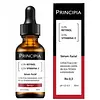What's inside
What's inside
 Key Ingredients
Key Ingredients

 Benefits
Benefits

 Concerns
Concerns

 Ingredients Side-by-side
Ingredients Side-by-side

Water
Skin ConditioningPolyacrylate Crosspolymer-6
Emulsion StabilisingSodium Gluconate
Skin ConditioningPropanediol
SolventC15-19 Alkane
SolventArachidyl Alcohol
EmollientBehenyl Alcohol
EmollientArachidyl Glucoside
EmulsifyingTocopheryl Acetate
AntioxidantRetinol
Skin ConditioningPolysorbate 20
EmulsifyingBHT
AntioxidantBHA
AntioxidantSodium Diethylenetriamine Pentamethylene Phosphonate
Sodium Gluceptate
Phenoxyethanol
PreservativeCaprylyl Glycol
EmollientWater
Skin ConditioningCyclopentasiloxane
EmollientButylene Glycol
HumectantDipropylene Glycol
HumectantGlycerin
HumectantPEG-12 Dimethicone Crosspolymer
EmulsifyingDimethicone/Vinyl Dimethicone Crosspolymer
Skin ConditioningDimethiconol
EmollientDimethicone
EmollientLaureth-23
CleansingLaureth-4
EmulsifyingPentylene Glycol
Skin ConditioningAcetyl Carboxymethyl Cocoyl Glycine
Retinyl Sunflowerseedate
Skin ConditioningPolysorbate 80
EmulsifyingRetinol
Skin ConditioningMyristoyl Nonapeptide-3
Skin ConditioningMyristoyl Pentapeptide-17
Skin ConditioningMyristoyl Tetrapeptide-13
Skin ConditioningLysophosphatidic Acid
Skin ConditioningAscorbyl Linoleate
AntioxidantEthyl Linoleate
EmollientEthyl Formate
PerfumingSodium Hyaluronate
HumectantAllantoin
Skin ConditioningPanthenol
Skin ConditioningSodium Ascorbyl Phosphate
AntioxidantPolyaminopropyl Biguanide
PreservativeTromethamine
BufferingWater, Cyclopentasiloxane, Butylene Glycol, Dipropylene Glycol, Glycerin, PEG-12 Dimethicone Crosspolymer, Dimethicone/Vinyl Dimethicone Crosspolymer, Dimethiconol, Dimethicone, Laureth-23, Laureth-4, Pentylene Glycol, Acetyl Carboxymethyl Cocoyl Glycine, Retinyl Sunflowerseedate, Polysorbate 80, Retinol, Myristoyl Nonapeptide-3, Myristoyl Pentapeptide-17, Myristoyl Tetrapeptide-13, Lysophosphatidic Acid, Ascorbyl Linoleate, Ethyl Linoleate, Ethyl Formate, Sodium Hyaluronate, Allantoin, Panthenol, Sodium Ascorbyl Phosphate, Polyaminopropyl Biguanide, Tromethamine
Ingredients Explained
These ingredients are found in both products.
Ingredients higher up in an ingredient list are typically present in a larger amount.
Retinol is a gold-standard ingredient for anti-aging. It is a form of Vitamin A and belongs to the class of retinoids that also includes tretinoin.
Why is retinol famous?
It has the most scientific studies backing up its skin benefits out of all the non-prescription ingredients.
Retinol is proven to:
This is why retinol is effective at removing wrinkles, fading dark spots, treating acne, and reducing the appearance of pores.
Studies show retinol is less effective when exposed to UV. Be sure to look for appropriate packaging to keep your retinol potent (similar to Vitamin C).
Using retinol or any retinoids will increase sun-sensitivity in the first few months. Though studies show retinoids increase your skin's natural SPF with continuous use, it is best to always wear sunscreen and sun-protection.
We recommend speaking with a medical professional about using this ingredient during pregnancy.
Retinol may cause irritation in some people, so be sure to patch test. Experts recommend 'ramping up' retinol use: start using this ingredient once a week and work up to using it daily.
Read about Tretinoin
Learn more about RetinolWater. It's the most common cosmetic ingredient of all. You'll usually see it at the top of ingredient lists, meaning that it makes up the largest part of the product.
So why is it so popular? Water most often acts as a solvent - this means that it helps dissolve other ingredients into the formulation.
You'll also recognize water as that liquid we all need to stay alive. If you see this, drink a glass of water. Stay hydrated!
Learn more about Water